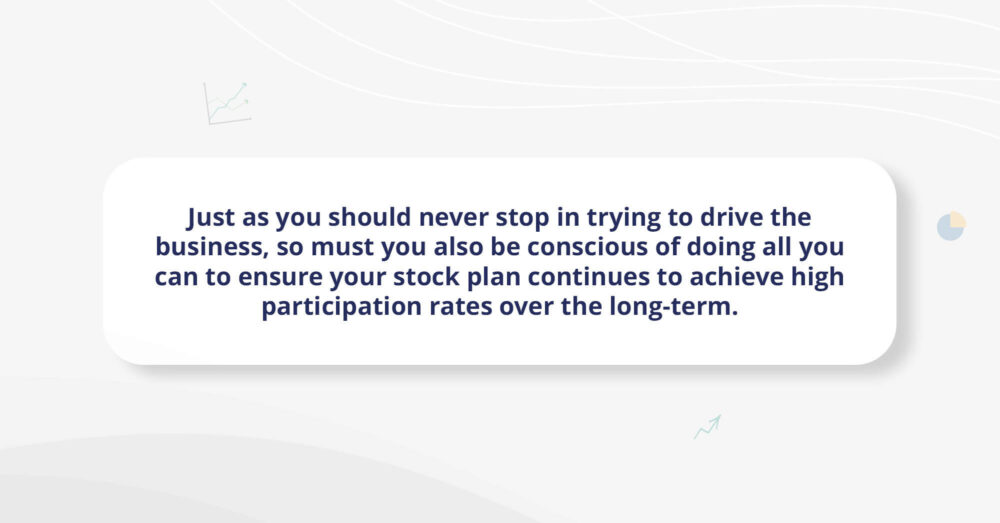Resting on your laurels or standing still is a no-no in business. Any company that isn’t consciously attempting to move forward will most likely sooner or later find itself going backward.
Just as that point is a widely accepted truism as it relates to day-to-day business, so too does it apply to your employee stock plan offering. Just because you may have had a successful launch for one or more plans at some point in the past does not mean you can merely assume that things will continue to tick over indefinitely, that later sign-up periods (if applicable) will proceed as smoothly as the initial wave, or that new recruits will choose to become participants in whatever plans are on offer merely because those plans exist.
In other words, the work doesn’t end. Just as you should never stop in trying to drive the business, so must you also be conscious of doing all you can to ensure your stock plan continues to achieve high participation rates over the long-term.
Precisely what taking on that challenge looks like will depend upon your particular set of circumstances. For example, if your company went public three to five years ago, you may have launched a new equity plan to coincide with that IPO. Fast forward to now and what served your needs and those of employees then may not be as good a fit as it used to be, or maybe it is, but you need to remind your people of that fact and/or let subsequent hires know what there is to be enthused about in the first place.
Typically, the challenge may be two-fold, relating both to placing a renewed emphasis on the communications and education strategy designed to promote the plan, and also perhaps a need to tweak elements that might now seem less attractive than they once did, i.e., maybe you opted for lengthy vesting periods day one, but in 2023, with the post-pandemic recruitment and retention situation so much more competitive than it was pre-2020, many companies are looking at accelerated vesting in an effort to make their employee stock plans more attractive to employees.
Let’s look at each of those – communications and vesting – in turn.
Revisit your stock plan communications strategy
You did it once, now you need to do it again.
Whether it’s a long-term incentive plan (LTIP) or employee stock purchase plan (ESPP), the best stock plan the world has ever seen would almost certainly fall short of its potential without an effective communications and education plan behind it. Your employees need to understand what is being proposed and why it is in their interests to sign up. If those messages are not communicated clearly, at the right time, and using the right combination of methods (i.e., appropriate to your target audience), then you will almost certainly not secure the participation rate that you otherwise might.
If your initial launch was successful, then most likely you understood all of these points at that time and developed the right approach to get your message out there on day one. Now, a few years down the line and in what might be somewhat different circumstances (i.e., as mentioned above on the changed recruitment and retention landscape), the challenge is to revisit that communications strategy and unroll it again, making whatever tweaks and adjustments might be necessary, as you seek to support your overall goal of boosting internal awareness of your stock plan and motivating your people to either sign up again or do so for the first time.
So, what are the key elements of an effective communications strategy?
#1: Put together the right team: First, figure out the various skills that are likely to be required. Then, identify the right internal people to develop and drive the campaign. Typically, you would be looking towards Marketing, HR, and Sales personnel to make up the team.
#2: Recognize that it’s a marketing campaign and proceed accordingly: The obvious times to get people to sign up are when they are hired or promoted. That’s the (relatively) easy part. But what about other times, when employees are focused on their day-to-day role and it can be difficult to capture their attention for something not directly related to the doing of their job? Inherent difficulties such as this require that you treat your communications strategy as a marketing campaign, because that’s exactly what it is. That being the case, you need to think about where each employee is in their “life cycle” with the company at any given moment, from the time they join until the moment they depart and customize content accordingly.
#3: Education is king: If employees don’t understand what is being proposed or how it will benefit them, then your stock plan is doomed or at the very least destined to underachieve. So, make sure that the campaign demystifies what can seem like an arcane area to the uninitiated. Be conscious of your various audiences and pitch the message accordingly, but with an emphasis on giving people clear facts and allowing them to then make an informed decision.
#4: Deadlines and scheduled events: Formal plan enrollment deadlines are frequently associated with an ESPP. If that applies in your case, it is important that you make it clear as early as possible in the process what those deadlines are, with a view towards focusing minds on the need to get up to speed on what is being proposed and for people to make a decision on whether to participate or not before that deadline passes. Also, giving people assigned times during the workday to attend training or information sessions can have the effect of jolting them into action.
#5: Put a human face on the campaign: Ultimately, people are going to buy from people. No matter how sophisticated or multi-faceted the campaign is (e.g., sending emails, infographics, and videos), if you want people to truly understand and engage with the plan, that will most likely come from conversations with other employees in the workplace. That means you need to find champions from within who can reach out to their colleagues and be credible advocates for the plan. Combined with easy-to-understand materials, a compelling pro-plan voice from within can prove to be a key piece of the jigsaw.
Taking the above steps both when you are first launching your ESPP or LTIP and then intermittently over the following years to renew interest internally can go a long way towards helping you to maintain a viable and successful plan into the medium- and long-term.

Consider accelerated vesting
Another key piece of the jigsaw may be to consider offering accelerated vesting terms to participants.
Typically, vesting takes place in the following ways:
Milestone-based: Stock awards are linked to the achievement of performance-related goals. These objectives can relate either to the individual, the company, or both. Individual goals might involve sales targets, while at the company level, the trigger might be an acquisition or an IPO.
Time-based: With a time-based approach, awards are linked to employees staying with the company for a specified minimum number of years. This would typically play out over up to five years, with stock vesting gradually over that period or all at once at the end.
Hybrid: It is not unusual for awards to be linked to both milestones and time, with stock not being formally handed over until both sets of goals have been achieved.
With accelerated vesting, companies choose to speed up the process. In practice, this means that employees receive their stock sooner than they would under the traditional vesting approaches listed above. For example, as mentioned previously, with time-based, vesting periods of up to five years are not unusual. With accelerated vesting, companies make a conscious decision to bring that schedule forward, so that employees do not have to wait so long to receive their full allocation of stock.
In part, the logic behind accelerated vesting is that it can make a company’s stock plan more attractive to employees, who, not unreasonably, will like the idea of receiving 100% of their award sooner rather than later. And, as pointed out above, with recruitment and retention perhaps more challenging than ever before for companies, finding ways to keep existing employees happy and making yourself more attractive to potential new hires is of the utmost importance.
Want to find out more?
At Global Shares we understand the importance of ensuring that your stock plan is fit for purpose and the need to properly communicate the key information to your people. So, whether you are looking to revamp or merely tweak an existing stock plan, and/or want to speak about communications packages, our experienced personnel are just a phone call away. Feel free to contact us today.
This publication contains general information only and J.P. Morgan Workplace Solutions is not, through this article, issuing any advice, be it legal, financial, tax-related, business-related, professional or other. J.P. Morgan Workplace Solutions’ Insights is not a substitute for professional advice and should not be used as such. J.P. Morgan Workplace Solutions does not assume any liability for reliance on the information provided herein.



